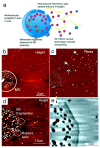Salivary Exosomes as Nanocarriers for Cancer Biomarker Delivery
- PMID: 30795593
- PMCID: PMC6416587
- DOI: 10.3390/ma12040654
Salivary Exosomes as Nanocarriers for Cancer Biomarker Delivery
Abstract
Human saliva is an ideal body fluid for developing non-invasive diagnostics. Saliva contains naturally-occurring nanoparticles with unique structural and biochemical characteristics. The salivary exosome, a nanoscale extracellular vesicle, has been identified as a highly informative nanovesicle with clinically-relevant information. Salivary exosomes have brought forth a pathway and mechanism by which cancer-derived biomarkers can be shuttled through the systemic circulation into the oral cavity. Despite such clinical potential, routine and reliable analyses of exosomes remain challenging due to their small sizes. Characterization of individual exosome nanostructures provides critical data for understanding their pathophysiological condition and diagnostic potential. In this review, we summarize a current array of discovered salivary biomarkers and nanostructural properties of salivary exosomes associated with specific cancers. In addition, we describe a novel electrochemical sensing technology, EFIRM (electric field-induced release and measurement), that advances saliva liquid biopsy, covering the current landscape of point-of-care saliva testing.
Keywords: biomarker; cancer; liquid biopsy; point-of-care; saliva-exosomics; salivaomics; salivary diagnostics.
Conflict of interest statement
D.T.W.W. is the co-founder of RNAmeTRIX Inc., a molecular diagnostic company. D.T.W.W. holds equity in RNAmeTRIX and serves as a company Director and Scientific Advisor. The University of California also holds equity in RNAmeTRIX. Intellectual property that D.T.W.W. invented and that was patented by the University of California has been licensed to RNAmeTRIX. D.T.W.W. is a consultant to GlaxoSmithKline, PeriRx, Wrigley, and Colgate-Palmolive.
Figures






Similar articles
-
Saliva diagnostics: Salivaomics, saliva exosomics, and saliva liquid biopsy.J Am Dent Assoc. 2023 Aug;154(8):696-704. doi: 10.1016/j.adaj.2023.05.006. J Am Dent Assoc. 2023. PMID: 37500232 Free PMC article. Review.
-
Saliva-Exosomics in Cancer: Molecular Characterization of Cancer-Derived Exosomes in Saliva.Enzymes. 2017;42:125-151. doi: 10.1016/bs.enz.2017.08.002. Epub 2017 Oct 9. Enzymes. 2017. PMID: 29054268 Free PMC article. Review.
-
Saliva Diagnostics.Annu Rev Anal Chem (Palo Alto Calif). 2022 Jun 13;15(1):107-121. doi: 10.1146/annurev-anchem-061020-123959. Annu Rev Anal Chem (Palo Alto Calif). 2022. PMID: 35696523 Free PMC article. Review.
-
Saliva diagnostics - Current views and directions.Exp Biol Med (Maywood). 2017 Mar;242(5):459-472. doi: 10.1177/1535370216681550. Epub 2016 Dec 8. Exp Biol Med (Maywood). 2017. PMID: 27903834 Free PMC article. Review.
-
Detection of exosomal biomarker by electric field-induced release and measurement (EFIRM).J Vis Exp. 2015 Jan 23;(95):52439. doi: 10.3791/52439. J Vis Exp. 2015. PMID: 25650727 Free PMC article.
Cited by
-
Next generation sequencing-based salivary biomarkers in oral squamous cell carcinoma.J Korean Assoc Oral Maxillofac Surg. 2022 Feb 28;48(1):3-12. doi: 10.5125/jkaoms.2022.48.1.3. J Korean Assoc Oral Maxillofac Surg. 2022. PMID: 35221302 Free PMC article. Review.
-
Saliva diagnostics: Salivaomics, saliva exosomics, and saliva liquid biopsy.J Am Dent Assoc. 2023 Aug;154(8):696-704. doi: 10.1016/j.adaj.2023.05.006. J Am Dent Assoc. 2023. PMID: 37500232 Free PMC article. Review.
-
A novel assay for exosomal and cell-free miRNA isolation and quantification.RNA Biol. 2020 Apr;17(4):425-440. doi: 10.1080/15476286.2020.1721204. Epub 2020 Feb 10. RNA Biol. 2020. PMID: 31986967 Free PMC article.
-
Liquid biopsy into the clinics: Current evidence and future perspectives.J Liq Biopsy. 2024 Feb 11;4:100146. doi: 10.1016/j.jlb.2024.100146. eCollection 2024 Jun. J Liq Biopsy. 2024. PMID: 40027149 Free PMC article. Review.
-
Royal jelly extracellular vesicles promote wound healing by modulating underlying cellular responses.Mol Ther Nucleic Acids. 2023 Feb 14;31:541-552. doi: 10.1016/j.omtn.2023.02.008. eCollection 2023 Mar 14. Mol Ther Nucleic Acids. 2023. PMID: 36895953 Free PMC article.
References
-
- Gerlinger M., Rowan A.J., Horswell S., Math M., Larkin J., Endesfelder D., Gronroos E., Martinez P., Matthews N., Stewart A., et al. Intratumor heterogeneity and branched evolution revealed by multiregion sequencing. N. Engl. J. Med. 2012;366:883–892. doi: 10.1056/NEJMoa1113205. - DOI - PMC - PubMed

